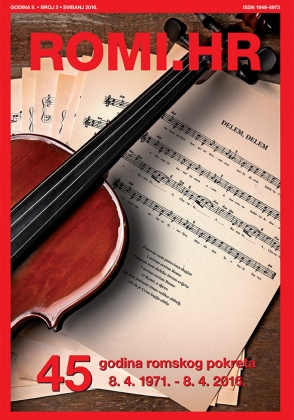Features ROMI.HR
/_-_the_suppliants,_expulsion_of_the_gypsies_from_spain_-_thc0038_-_royal_holloway,_university_of_london.jpg) Edwin Long (1829-1891) - The Suppliants, Expulsion of the Gypsies from Spain - THC0038 - Royal Holloway, University of London
Edwin Long (1829-1891) - The Suppliants, Expulsion of the Gypsies from Spain - THC0038 - Royal Holloway, University of London For many centuries, art has acted as a bridge between people and the message that the author was trying to convey. Edwin Longsden Long's «The Suppliants: Expulsion of the Gypsies from Spain» is a prime example of art depicting tragic historical events. Painted in 1872, this work reflects the emotional tension and drama associated with the expulsion of Roma from Spain. To know more about the painting that became a visual historical document, go on our website ROMI.HR.
For many centuries, art has acted as a bridge between people and the message that the author was trying to convey. Edwin Longsden Long's «The Suppliants: Expulsion of the Gypsies from Spain» is a prime example of art depicting tragic historical events. Painted in 1872, this work reflects the emotional tension and drama associated with the expulsion of Roma from Spain.
The painting is made in the style of academic realism, which was popular in the Victorian era. This style is characterized by precise detailing, the use of dramatic lighting, and a desire for historical accuracy. Academic realism aimed to create emotionally rich and visually believable scenes, as seen in Long's works.
Edwin Longsden Long (1829-1891) was a British artist known for his historical and ethnographic paintings. He was born in Bath, England, and studied at the London School of Fine Art. Long traveled extensively in Spain and the Middle East, which greatly influenced his artistic vision and choice of subjects for his work. His paintings were distinguished by attention to detail and a desire for historical and ethnographic accuracy.
Edwin Long reached the pinnacle of his Spanish period in 1872 with the creation of a large historical painting titled "The Suppliants: Expulsion of the Gypsies from Spain". This artwork, currently displayed at Royal Holloway College in London, was the result of extensive research. Long visited the Prado Museum in Madrid to sketch accurate portraits of the King, Queen, and Cardinal, and also studied the architectural details of the church of Santa Annunciata. In a letter dated June 1, 1882, found in the Royal Holloway College Archives, Long discusses the historical context of the painting, noting that in 1619, the young queen intervened at Santa Annunciata in Valladolid to prevent the expulsion of the Roma. When exhibited at the Royal Academy in 1872, the painting was met with critical acclaim.
The painting "The Suppliants: Expulsion of the Gypsies from Spain" depicts a group of Roma begging for mercy. The central place is occupied by the figure of a woman with a child, their faces express despair and fear. They stand surrounded by other Roma who share their sentiments.
The expulsion of Roma from Spain began in 1492, when Catholic monarchs Ferdinand II of Aragon and Isabella I of Castile decreed the expulsion of Jews and Muslims. In subsequent years, the Roma were also subjected to severe persecution and expulsion. The policy of expulsion was part of Spain's broader strategy of religious and cultural unification, aimed at eliminating all "foreign" elements from society. In the 18th century, under Charles III, further measures were taken to expel the Roma, which only worsened their situation and suffering.
Long uses detailed drawing to convey the emotional states of his characters. Roma's faces express pleading. One of the men takes off his hat, some of the people are on their knees with their hands folded in a gesture of supplication or with their arms open, showing vulnerability and despair, which makes the scene especially touching. The artist uses light and shadow to create a dramatic effect. The central figures are brighter, which draws attention to their expressions and enhances the emotional impact. The clothing of the Roma is depicted with great accuracy, reflecting their cultural characteristics and social status: their bodies are covered with robes and pieces of fabric; Compared to all the other characters depicted, they are barefoot, their clothes are the simplest and most revealing. The surrounding details are also done with a high level of precision, which adds realism to the picture.
The painting “The Suppliants” is important not only as a work of art, but also as a historical document that raises the topic of persecution and suffering of the Roma people. It raises awareness of the historical injustices and brutalities faced by Roma in Spain. The painting is also an example of how art can serve as a means of documenting and understanding history.
Although Long's painting is unlikely to have significantly changed public attitudes towards Roma, it has become part of a cultural heritage that contributes to an understanding of their history and suffering. Artworks like these help create a fuller and more sympathetic understanding of the Roma people and their centuries-long struggle for survival and recognition.
"The Suppliants: Expulsion of the Gypsies from Spain" by Edwin Long is not only a significant work of fiction, but also a powerful historical document. The painting helps to understand and realize the scale of the tragedies that befell the Roma people, and emphasizes the importance of preserving historical memory through art. It is important to continue studying and understanding such works for a deeper understanding of historical and cultural processes.
 Back to Features
Back to Features












